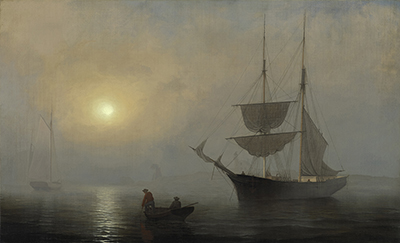PRINCETON, N.J. — An archetype of American painting by Luminist master Fitz Henry Lane (1804–65) titled “Ship in Fog,” circa 1860, has been acquired by the Princeton University Art Museum. The oil on canvas painting dramatically bolsters the museum’s esteemed holdings of American art, particularly American Luminism, and will substantially increase the collection’s utility as a research and teaching resource.

“Ship in Fog, Gloucester Harbor” by Fitz Henry Lane, circa 1860, oil on canvas. 24 by 39 inches. Princeton University Art Museum, museum purchase made possible by the Fowler McCormick, Class of 1921, Fund; the Kathleen C. Sherrerd Program Fund for American Art; and Celia A. Felsher, Class of 1976, and John L. Cecil, Class of 1976.
“Ship in Fog” is set in Gloucester Harbor from the vantage point of the open water, looking toward land. Lane rendered several seagoing vessels in a shroud of fog illuminated by the hazy late-afternoon sun, with the harbor’s Ten Pound Island and its lighthouse barely visible in the middle distance. In sharper focus in the foreground appear the backs of two figures in a rowboat and a meticulously rendered schooner brig at anchor nearby. It has been suggested that the figures in the rowboat may represent the artist himself and a friend working as an assistant, per Lane’s practice of initially sketching compositions from the water.
The painting’s subject, however, is arguably the fog itself, the most difficult of atmospheric conditions for a painter to render. Lane’s mastery of the subject comes from his late period, when his assurance and expressiveness combined to create canvases of both timeless harmony and visual logic, infused with a profound quietude.
The work was acquired from a private collection in New York and had previously been exhibited at the Princeton University Art Museum, under different ownership, as part of the special exhibitions “American Art from the Class of 1953 Collections” (1993) and “In Celebration: Works of Art from the Collections of Princeton Alumni and Friends of The Art Museum, Princeton University” (1997).
“In certain great works of his late career, Lane gravitated away from portrayal of the crystalline light that served as an essential feature of his early maturity and toward an exploration of more complex atmospheric conditions, such as fog,” said Karl Kusserow, the museum’s John Wilmerding curator of American art. “Although ‘Ship in Fog’ portrays a relatively modest scene — a variety of ordinary craft in a sizable but not major port at the end of a late-summer day — what makes the painting extraordinary is Lane’s ability, unsurpassed in American art, to impart a resonant grandeur to such moments, as if to impress them both in time and for all time.”
Born in Gloucester, Lane was the son of a sailmaker and was crippled from childhood. He began his painting and printmaking career as a portraitist of ships. Lane subsequently experimented with the effects of light in various marine and coastal scenes, developing an inspired artistic vision that assigned meditative and romantic qualities to a particular moment in time.
Keenly interested in portraying the character and poetry of light as well as the union of the material and the spiritual, Nineteenth Century Luminists took elements from European Romanticism and from Ralph Waldo Emerson’s Transcendentalist views on the individual and nature to inaugurate a uniquely American style of atmospheric stillness and clarity of detail derived from direct observation.
“Ship in Fog” is currently on view in the museum’s galleries of American art, and will be a part of special exhibitions and will be actively studied by undergraduate and graduate students and by visiting scholars in a broad range of disciplines.
The new acquisition complements other, related works in the museum’s American collection, including Winslow Homer’s watercolor masterpiece “Eastern Point Light,” 1880, executed from the same location on the water as “Ship in Fog” but looking instead out to sea; John Kensett’s evocative late Luminist “Lake George,” circa 1870; and James Buttersworth’s “Clipper Ship Staghound,” circa 1855, depicting what was once the largest merchant ship in the world.
For information, 609-258-3788 or www.princeton.edu.

